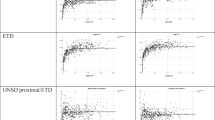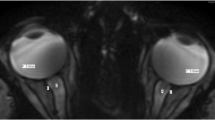Abstract
Introduction
Our purpose was to evaluate the diagnostic value of measuring diameters of optic nerve sheath (ONSD), presence/absence of papilledema, tortuosity of the optic nerve, flattening of the posterior sclera, and intraocular protrusion of the prelaminar optic nerve for intracranial pressure assessment in cases of Chiari I malformation.
Methods
In a retrospective study, MRI data of 37 consecutive pediatric patients with Chiari malformation and data of 400 patients without intracranial pathology were compared and analyzed. ONSDs were measured at the point where the ophthalmic artery crosses the optic nerve (anatomical landmark). The correlation analysis was performed with clinical findings, gender, age, papilledema, and other neuro-ophthalmological findings.
Results
ONSD was enlarged in 38 % of cases of Chiari malformation. The enlargement was bilateral, no correlation with age or gender was found (p = 0.67 and p = 0.76, respectively). The presence of papilledema was detected in 19 % of cases presenting less valuable diagnostic sign if compared with ONSD. The tortuosity of the optic nerve was found in 22 % of cases, but in three patients, it was unilateral. All patients with enlarged ONSD and other neuro-ophthalmological signs present were treated surgically, while most of the patients without these signs (20/23) were treated conservatively.
Conclusion
In majority of pediatric cases of Chiari malformation, the ONSD is not enlarged and other neuro-ophthalmological signs are not present. Detecting the enlarged ONSD and other neuro-ophthalmological signs in cases of Chiari malformation may indicate the elevated intracranial pressure and necessity for urgent surgical intervention.


Similar content being viewed by others
References
Demols P, Vilain S, Van Nechel C (1998) Association of idiopathic intracranial hypertension-Arnold-Chiari deformity: danger! Bull Soc Belge Ophtalmol 268:153–158
Kurschel S, Maier R, Gellner V, Eder HG (2007) Chiari I malformation and intra-cranial hypertension: a case-based review. Childs Nerv Syst 23(8):901–905
Ahad R, Kossoff EH (2008) Secondary intracranial causes for headaches in children. Curr Pain Headache Rep 12(5):373–378
Kasner SE, Rosenfeld J, Farber RE (1995) Spontaneous intracranial hypotension: headache with a reversible Arnold-Chiari malformation. Headache 35(9):557–559
Dora B, Nikolaos B, Stylianos G, Damianos S (2013) Intracranial hypotension syndrome in a patient due to suboccipital craniectomy secondary to Chiari type malformation. World J Clin Cases 1(9):295–297. doi:10.12998/wjcc.v1.i9.295
Leonard JR, Limbrick DD Jr (2015) Chiari I malformation: adult and pediatric considerations. Neurosurg Clin N Am 26(4):xiii–xxiv. doi:10.1016/j.nec.2015.07.002
Kimberly HH, Shah S, Marill K et al (2008) Correlation of optic nerve sheath diameter with direct measurement of intracranial pressure. Acad Emerg Med 15:201–204
Helmke K, Hansen HC (1996) Fundamentals of transorbital sonographic evaluation of optic nerve sheath expansion under intracranial hypertension. I. Experimental study. Pediatr Radiol 26:701–705
Padayachy LC, Kilborn T, Carrara H, Figaji AA, Fieggen GA (2015) Change in optic nerve sheath diameter as a radiological marker of outcome from endoscopic third ventriculostomy in children. Childs Nerv Syst 31(5):721–728. doi:10.1007/s00381-015-2655-0
Steinborn M, Friedmann M, Hahn H, Hapfelmeier A, Macdonald E, Warncke K, Saleh A (2015) Normal values for transbulbar sonography and magnetic resonance imaging of the optic nerve sheath diameter (ONSD) in children and adolescents. Ultraschall Med 36(1):54–58. doi:10.1055/s-0034-1385012
Singhal A, Yang MM, Sargent MA, Cochrane DD (2013) Does optic nerve sheath diameter on MRI decrease with clinically improved pediatric hydrocephalus? Childs Nerv Syst 29(2):269–274. doi:10.1007/s00381-012-1937-z
Passi N, Degnan AJ, Levy LM (2013) MR imaging of papilledema and visual pathways: effects of increased intracranial pressure and pathophysiologic mechanisms. AJNR Am J Neuroradiol 34:919–924
Zhang JC, Bakir B, Lee A, Yalamanchili SS (2011) Papilloedema due to Chiari I malformation. BMJ Case Rep 2011. doi:10.1136/bcr.08.2011.4721 pii: bcr0820114721
Milhorat TH, Chou MW, Trinidad EM, Kula RW, Mandell M, Wolpert C, Speer MC (1999) Chiari I malformation redefined: clinical and radiographic findings for 364 symptomatic patients. Neurosurgery 44:1005–1017. doi:10.1097/00006123-199905000-00042
Deng X, Wu L, Yang C, Tong X, Xu Y (2013) Surgical treatment of Chiari I malformation with ventricular dilation. Neurol Med Chir (Tokyo) 53:847–852
Steinborn M, Fiegler J, Ruedisser K, Hapfelmeier A, Denne C, Macdonald E, Hahn H (2011) Measurement of the optic nerve sheath diameter in children: comparison between transbulbar sonography and magnetic resonance imaging. Ultraschall Med. doi:10.1055/s-0031-1273491
Vaiman M, Sigal T, Kimiagar I, Bekerman I (2016) Intracranial pressure assessment in traumatic head injury with hemorrhage via optic nerve sheath diameter. J Neurotrauma 2016. doi:10.1089/neu.2015.4293
Bekerman I, Sigal T, Kimiagar I, Almer ZE, Vaiman M (2016) Diagnostic value of the optic nerve sheath diameter in pseudotumor cerebri. J Clin Neurosci 30:106–109. doi:10.1016/j.jocn.2016.01.018
Shofty B, Ben-Sira L, Constantini S, Freedman S, Kesler A (2012) Optic nerve sheath diameter on MR imaging: establishment of norms and comparison of pediatric patients with idiopathic intracranial hypertension with healthy controls. AJNR Am J Neuroradiol 33(2):366–369. doi:10.3174/ajnr.A2779
Beare NA, Kampondeni S, Glover SJ, Molyneux E, Taylor TE, Harding SP, Molyneux ME (2008) Detection of raised intracranial pressure by ultrasound measurement of optic nerve sheath diameter in African children. Tropical Med Int Health 13(11):1400–1404. doi:10.1111/j.1365-3156.2008.02153.x
Massimi L, Della Pepa GM, Tamburrini G, Di Rocco C (2011) Sudden onset of Chiari malformation type I in previously asymptomatic patients. J Neurosurg Pediatr 8(5):438–442. doi:10.3171/2011.8.PEDS11160
Massimi L, Della Pepa GM, Caldarelli M, Di Rocco C (2012) Abrupt clinical onset of Chiari type I/syringomyelia complex: clinical and physiopathological implications. Neurosurg Rev 35(3):321–329 . doi:10.1007/s10143-012-0391-4discussion 329
De Guio F, Jouvent E, Biessels GJ et al (2016) Reproducibility and variability of quantitative magnetic resonance imaging markers in cerebral small vessel disease. J Cereb Blood Flow Metab 36(8):1319–1337. doi:10.1177/0271678X16647396
Belli G, Busoni S, Ciccarone A et al (2016) Quality assurance multicenter comparison of different MR scanners for quantitative diffusion-weighted imaging. J Magn Reson Imaging 43(1):213–219. doi:10.1002/jmri.24956
Giger-Tobler C, Eisenack J, Holzmann D et al (2015) Measurement of optic nerve sheath diameter: differences between methods? A Pilot Study Klin Monbl Augenheilkd 232:467–470
Acknowledgments
The authors would like to thank most sincerely Evelina Shevtsov, MD, Department of Neurology, who assisted us in our research.
Author information
Authors and Affiliations
Corresponding author
Ethics declarations
All procedures performed in studies involving human participants were in accordance with the ethical standards of the institutional research committee and with the 1964 Helsinki declaration and its later amendments or comparable ethical standards.
Conflict of interest
Michael Vaiman, Tal Sigal, Itzhak Kimiagar, Zina Evy Almer, and Inessa Bekerman declare that they have no conflict of interest.
Informed consent
The institutional review board of our institute approved this retrospective study, and the requirement to obtain informed consent was waived.
Rights and permissions
About this article
Cite this article
Bekerman, I., Sigal, T., Kimiagar, I. et al. Diagnostic value of neuro-ophthalmological signs in cases of Chiari I malformation. Childs Nerv Syst 32, 2423–2428 (2016). https://doi.org/10.1007/s00381-016-3270-4
Received:
Accepted:
Published:
Issue Date:
DOI: https://doi.org/10.1007/s00381-016-3270-4




